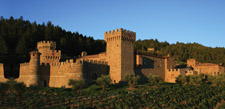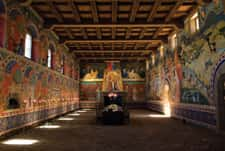|
|
Castello di Amorosa
4045 N. St. Helena Hwy. Calistoga, CA 94515 (707) 967-6272 www.castellodiamorosa.com
Hours: Daily 9:30 a.m.-6 p.m. (March-October); 9:30 a.m.-5 p.m. (November-February) Tasting fees: $10 weekdays/$15 weekends for a tasting of five wines and limited access to the castle. Guided tours and more specialized tastings range from $25 to $68. Wines currently offered: Cabernet Sauvignon, Il Barone (100 percent Reserve Cabernet Sauvignon), Sangiovese, Merlot, Chardonnay, Pinot Grigio, Pinot Bianco, Gewürztraminer, Late Harvest Sauvignon Blanc/Semillon, Simpatica (Muscato and Riesling blend), Gioia (Rosé of Sangiovese), Il Brigante (Cabernet/Merlot blend), La Castellana (a “super Tuscan” blend), La Fantasía (an Italian style sparkler), Il Raggio del Sole (Muscato Canelli) Appointment necessary: For guided tours, reserve tastings, carriage tours, chocolate and food pairings, blending seminars and other specialized visits. Picnics: No
|
Featuring Castello di Amorosa in our Great Tastes section is a no-brainer—it’s a medieval castle, for crying out loud! But we have other motives, as well.
In 1975, the same year Sonoma Business magazine hatched in the brains of three Sonoma County entrepreneurs, a fourth-generation Italian American named Dario Sattui set about relaunching his great-grandfather Vittorio’s winery business (V. Sattui) in Napa Valley. And just as Sonoma Business eventually came to encompass more than its original vision (as NorthBay biz), so did Sattui’s enterprise.
In 1994, Sattui began work on a second winery. Inspired by European travels and his love of medieval architecture and artistry, he first envisioned an 8,500-square-foot Tuscan winery. What he ended up with, 14 years later, was a 121,000-square-foot, eight-level (four above ground, four below), circa 12th century castle, complete with a drawbridge, moat, towers, fortifications, secret passageways, an armory and torture chamber. Oh yeah, and a 16,000-case winery (98 of the castle’s 107 rooms are dedicated to winemaking or storage).
There are many ways to tour Castello di Amorosa, including a horse-drawn carriage ride through the vineyards, a variety of food and wine pairing choices (including chocolate!) and private promotional events. Zoning prohibits weddings on site, but you can arrange a special “proposal” tour for two that ends in a romantic tower setting, complete with a bottle of wine. We took the standard guided tour ($25-$30), which includes both the castle and underground caves and cellars.
Nothing you read here will fully capture the experience of walking through arched passages, built using hand-hewn stone from local rock quarries and coupled with ancient brick from Austria, Italy and other parts of Europe (Sattui imported 171 shipping containers full of bricks from Europe), or of standing in the Great Hall, where contemporary Italian artisans used traditional methods to create period-accurate, two-story frescoes depicting idyllic agrarian life (on one wall) and the temptations of the flesh and supremacy of the king (on the opposite). My mind kept racing back to my high school art appreciation classes; my teacher, Father Shaw, would love this place.
Our tour starts with some background about Sattui himself and a lesson on the evolution of castles. True historic castles developed over many generations, often being remodeled or expanded to suit the needs/whims of successive rulers. Castello di Amorosa was designed by Sattui (who spent almost 30 years researching medieval architecture) with the help of St. Helena’s Lail Design to mimic the architectural styles and incorporate the construction techniques of progressive centuries. A consecrated chapel (Latin mass is read every Sunday at 8:30 a.m.) is styled as it would have been in the 13th century; it typically would have been the first community structure built, with the castle developing around it little by little.
Stepping from the chapel into an interior courtyard, our guide, PR/marketing manager James Sullivan, points out adjoining walls using 12th and 13th century-style construction. We travel through time, step through centuries-old doors and hear how Sattui imported not just materials, but also an initial workforce trained in old world methods. Eventually, these (mostly) Italian laborers were ready to move on (construction took more than 14 years), but they trained locals in their methods before returning to their homelands.
Our tour takes us up a tower, where we enjoy sweeping views of Castello di Amorosa vineyards (31 acres of the Diamond Mountain estate are planted to Cabernet Sauvignon, Sangiovese, Merlot and Primativo). Next we’re treated to a look at the winery facilities before heading below ground, where a well-stocked armory (including suits of armor, maces, swords and other weaponry) leads to a torture chamber and dungeons. An iron maiden, stretching rack, spiked chair and hanging cage lend an air of doom to this section of the tour. Creepy but fascinating.
The 900 linear feet of caves (including a separate wing for library wines) and a 12,000-square-foot Grand Barrel room are impressive, but it’s not all about imposing scale and mind-boggling attention to detail. There are also sweet, homey elements and touches.
When we drive up, we have to pause at the parking lot entrance as two meandering sheep cross slowly from one vineyard to another. As we wait to check in, Guinevere the cat stops in to collect strokes from winery visitors (her brother, Sir Lancelot, is said to be nearby). And though many wineries are strictly set up for adult fun, Castello di Amorosa offers minors complimentary juice from the tasting bar, and a coloring table has been set up in one of the ancillary tasting rooms for their entertainment as well. After all, what kid wouldn’t want to see a real castle?
When we finally reach the tasting bar, it’s crowded, loud and a little rowdy—this is definitely not a stodgy room. The bar is large, but the space is larger. And everywhere you look, there’s more to explore. Tables and racks display a vast variety of goods—some wine and food related, others tied to Sattui’s love of the medieval and all things Italian.
Cookbooks, gourmet foodstuffs and interesting kitchen and serving ware is interspersed with books on Napa Valley and medieval history, apparel and jewelry, soaps, lotions and “antiquities” and special story and coloring books (among other things) for younger visitors. There’s so much to see…and taste.
Castello di Amorosa produces many different wines, and with guidance from assistant tasting room manager Gary Stoffers, we begin working our way through. We try a few whites, including a 2008 Anderson Valley Pinot Grigio (apples and citrus elements, and much lighter than other Pinot Grigios I’ve tried) and a 2007 Anderson Valley Gewürztraminer. The 2008 Rosé of Sangiovese is a standout: beautiful color, smelling of roses and tasting like ripe strawberries.
The reds are next. The standouts for us are the 2005 Napa Valley Merlot (anise and cocoa nose, bing cherries and a silky mouthfeel on the finish) and the ’05 Reserve Napa Valley La Castellana, a “Super Tuscan” blend of Cabernet Sauvignon, Merlot and Sangiovese (cedar and leathery nose, berry pie flavors).
Director of winemaking Brooks Painter also crafts dessert wines, and our favorites are the 2006 Il Passito, a reserve Late Harvest Semillion (think crème brulee), and the 2007 Late Harvest Anderson Valley Gewürztraminer (perfumey nose with sweet apricots on the palate).
By the time we left, our palates were pleased and our architectural knowledge was expanded—I never knew a winery could be so enriching. And since Castello di Amorosa’s delicious wines are only available at the castle or online…there’s no excuse not to visit.
Did You Know?
• The authentic European doors leading into the Great Hall weigh 1,000 pounds and contain 2,000 handmade nails.
• The fireplace in the Great Hall (10 feet long by 8 feet tall) dates back to 1447. Sattui had it dismantled in Europe before it was shipped and reassembled at Castello di Amorosa.





